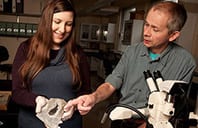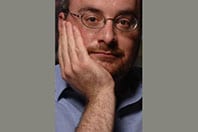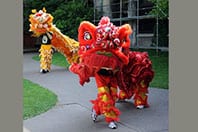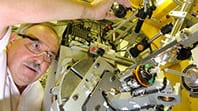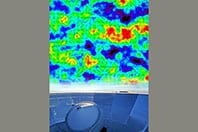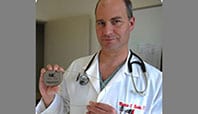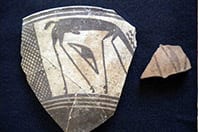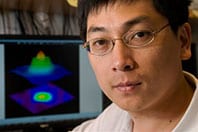Research and Scholarship
Prehistoric Fish Extinction Ushered in Modern Vertebrates
Modern vertebrates emerged after a mass extinction of fish 360 million years ago, according to a study led by graduate student Lauren Sallan. The study found that the extinction scrambled the species pool near the time at which the first vertebrates crawled from water toward land. The few species that survived the bottleneck were the evolutionary starting point for all vertebrates, including humans. Sallan worked closely with Michael Coates, Professor in Organismal Biology & Anatomy, as she examined fossils from the Devonian Period.
Next-Generation Supercomputing Gains NSF Support
A consortium that includes the University of Chicago has established FutureGrid, a collaborative next-generation system for experimental scientific supercomputing. FutureGrid allows scientists to experiment with new technologies or ideas at reasonable scale, and will draw on the University’s existing TeraGrid, a national system of interconnected supercomputers devoted to leading-edge scientific discovery and science and technology education. The $15 million FutureGrid project is largely supported by the National Science Foundation.
A $30 million National Science Foundation grant will enable the University to expand and extend until 2011 the operation of TeraGrid, the world’s largest computing network.
Grant Helps Unravel Internal Politics of Terrorist Violence
Ethan Bueno de Mesquita, Associate Professor in the Harris School of Public Policy Studies, received a three-year, $892,000 grant from the Office of Naval Research to study how the internal dynamics of terrorist and insurgent organizations affect their use of violence. His project, “Factions, Internal Competition, and Asymmetric Violence,” ultimately aims to increase the efficacy of counterinsurgency and counterterrorism tactics by better understanding the internal factors contributing to their external aggressions. His research will fill an important gap in the current terrorism literature.
Confucius Institute Launched to Support Research on China
As part of its ongoing commitment to research on China, the University collaborated with the Chinese Language Council International to establish a Confucius Institute on the Hyde Park campus. The Confucius Institute will support a broad program of research on China, including the work of faculty, graduate students, and undergraduates, in addition to language teaching, teacher training, and funding for study abroad. “China’s extraordinary transformation and growth on the world stage make this a crucial time to intellectually engage and understand the nation and its development,” said Dali Yang, the institute’s faculty director.
Inner Workings of Anthrax Revealed
The deadly bacterium anthrax, long feared for its potential as a biological weapon, is now a bit less mysterious, thanks to researchers at Argonne National Laboratory and the University of Chicago who have determined the structure of a protein crucial to its virulence. Having discovered the structure of one of the bacterium’s enzymes, researchers can begin to search for a molecule that could block its function, which in turn would make it more vulnerable to human defenses.
UCMC Joins National Study to Fight Unexplained Anemia
The University of Chicago Medical Center joined seven leading centers to study why unexplained anemia is so common in older adults and to find better treatments. A $16 million grant from the National Institute on Aging is funding the Partnership for Anemia: Clinical and Translational Trials in the Elderly. “Anemia in the elderly has been linked to decreased quality of life, impaired cognition, greater hospitalization, and even a greater risk of death,” said hematologist Andrew Artz, Assistant Professor in Medicine, director of the Medical Center’s geriatric anemia clinic, and co-principal investigator for the partnership.
Team Confirms Cosmologists’ Standard View of Universe
An international team that includes the University of Chicago unveiled a detailed picture of the seeds of structures in the universe. These measurements of the cosmic microwave background—a faintly glowing relic of the hot, dense, young universe—put limits on proposed alternatives to the standard model of cosmology and provide further support for that model, confirming that dark matter and dark energy make up 95 percent of everything in existence, while ordinary matter makes up just 5 percent.
UChicago Chemist Heads New Center for Chemical Innovation
Scientists at five American universities joined to create the Center for Energetic Non-Equilibrium Chemistry at Interfaces (CENECI), a collaborative effort to explore research aimed at spurring innovation and economic competitiveness. The University of Chicago’s Steven Sibener heads the team that includes collaborators from UChicago, MIT, Montana State University, Northwestern University, and the University of Wisconsin–Madison. The group will pursue new chemical transformations and catalysis under energetic conditions; materials growth, initially focusing on diamond growth for technological applications; and reactions in liquids.
Loneliness Has Health Risks and Can Spread
Chronic feelings of loneliness take a toll on blood pressure over time, causing a marked increase after four years, according to a new study. A University research team that has been exploring how loneliness affects health discovered the direct relation.
One of the team members, John Cacioppo, the Tiffany and Margaret Blake Distinguished Service Professor in Psychology, led another study that found that loneliness can be contagious. His team of scholars found that lonely people tend to share their loneliness with others. Gradually over time, a group of lonely, disconnected people moves to the fringes of social networks.
UCMC Pioneers Safer Defibrillator in the U.S.
The first U.S. recipient of a less invasive device that protects against sudden cardiac arrest had the device implanted at the University of Chicago Medical Center in March. The subcutaneous implantable cardioverter defibrillator (ICD) was approved for use in Europe in 2009 after nine years of development and clinical work across seven countries. The subcutaneous ICD detected 100 percent of induced and spontaneous irregular heart rhythms, and helped reduce problems associated with traditional models. Sudden cardiac arrest is a potentially fatal electrical malfunction of the heart.
Archaeologists Seek Clues about Dawn of Urban Civilization
A team of archaeologists from the Oriental Institute joined a team of Syrian colleagues in excavating a key site from the prehistoric society that formed the foundation of urban life in the ancient Middle East. The previously unexcavated Tell Zeidan site in northern Mesopotamia has already yielded evidence of trade in obsidian, rich agricultural production, and the development of copper processing—all of which flourished long before people domesticated pack animals for transportation or invented the wheel. Gil Stein, director of the Oriental Institute and a leader of the expedition, said the location’s potential for further discoveries is so great that the project is likely to last for decades.
NIH Grant Funds Bold Research Initiative
For a proposal that could revolutionize modern science, Shohei Koide, Associate Professor in Biochemistry & Molecular Biology, was among the first to win a new National Institutes of Health award totaling $2.8 million over five years. The Transformative R01 (T-R01) Award will fund his research to develop an innovative protein-capture technology with high levels of fidelity and predictability. Protein-capture reagents are molecules that allow researchers to detect and isolate proteins in a sample. His research “will fill a major void in available molecular tools and impact virtually all areas of molecular biomedical science, medical diagnosis, and drug development,” Koide said.
Dynamic New Assay Illuminates Protein Networks
A team of University scientists has invented a new assay capable of examining hundreds of proteins at once. The invention will enable new experiments that could dramatically change our understanding of cancer and other diseases. Called “micro-western arrays,” these new tools will allow scientists to observe much of a cell’s intricate protein network in one experiment rather than peeking at one small piece at a time. “This opens up a completely new window in terms of the molecular profiling of the cell,” said Andrea Califano of Columbia University.
New Weapon Fights against Deadly MRSA
Researchers at Argonne National Laboratory and the University of Chicago have been chasing the deadly MRSA (methicillin-resistant Staphylococcus aureus) bacterium that became a major health problem at some Chicago hospitals ten years ago. The team has developed a unique new computer model to understand how the bacterium spread across Chicago and how it might be prevented from spreading further. Using a technique called agent-based modeling, researchers will trace the social movements of Chicago-area populations to determine how to prevent the spread of this “flesh-eating bacterium.”
Technique Probes Hidden Dynamics of Molecular Biology
Funded by a $1 million grant from the W. M. Keck Foundation, University of Chicago scientists are aiming to develop a systematic method for determining how biological processes emerge from molecular interactions. The method may permit them to “rewire” the regulatory circuitry of insulin-secreting pancreatic beta cells, which play a major role in type-2 diabetes. “Despite the enormous amount of study directed at diabetes, there’s really very little understanding of the collective mechanisms that govern or regulate insulin secretion,” said project director Aaron Dinner, Associate Professor in Chemistry.
Political Views May Skew View of Skin Tone
Political affinity could influence how some people view the skin tone of biracial political candidates, according to a new study led by Eugene Caruso, Assistant Professor of Behavioral Science in Chicago Booth. The findings indicate that people perceive lighter skin tone to be more representative of a candidate with whom they share political ideology than darker skin tone. “Subtle differences in a person’s skin tone may affect other consequential decisions in which pictures are part of the evaluation process, such as who we hire for a job,” Caruso said.
Experiment Reveals Transition from Conductor to Insulator
University physicists directly observed for the first time a group of atoms transform from a conducting state into an insulating state. A team led by Cheng Chin, Assistant Professor in Physics, conducted the experiment as the first step in a project to simulate the dynamics of electrons in a solid. “How you can make the transition from a conducting material to a non-conducting material is difficult to conceive,” said Chin, but his team observed such a transition using super-cooled atoms to simulate the behavior of electrons.
Social Isolation Has Dangerous Links to Cancer
Using mice as a model to study human breast cancer, researchers have demonstrated that a negative social environment causes increased tumor growth. The work shows—for the first time—that social isolation is associated with altered gene expression in mouse mammary glands, and that these changes are accompanied by larger tumors. The interdisciplinary study was conducted by cancer specialist Suzanne D. Conzen, Associate Professor in Medicine, and Martha McClintock, the David Lee Shillinglaw Distinguished Service Professor in Psychology.
A University research team also found that social isolation and related stress contributes to breast cancer susceptibility. They found that isolation and stress result in a 3.3-fold increase in the risk of developing cancer among rats with naturally occurring mammary tumors.
Scholars Initiate Interdisciplinary Research on Virtues
A new initiative aims to bring together scholars in fields across the sciences, humanities, and religion to empirically study good behavior. The Arete Initiative, the University’s interdisciplinary research incubator, created the New Science of Virtues project. Nineteen scholars, including two UChicago faculty members, were selected to share a $3 million grant from the John Templeton Foundation to pursue their research. “The project is an attempt to bring together scholars from a variety of disciplines to explore the question of virtue and establish an organized, coherent body of knowledge, thus creating a ‘science’ of virtue,” said Jean Bethke Elshtain, the Laura Spelman Rockefeller Professor in the Divinity School.
Scientists Map Heart’s Regulation and Maintenance
Scientists have devised a new computational model that can be used to reveal genetic regulatory elements responsible for development of the human heart and maintenance of its function. The model helps scientists detect when genes switch on and off in different cells within the heart, but it also can be applied broadly to other tissues and has been used successfully to identify regulatory elements for cells in the limbs and brain.
Chemists Use Geometry to Influence Stem-Cell Development
University scientists successfully used geometrically patterned surfaces to influence the development of stem cells. The team found that making cells assume a star shape promotes a tense cytoskeleton, which provides structural support for cells, while a flower shape promotes a looser cytoskeleton. The new approach departs from that of many stem-cell biologists, who focus instead on uncovering the role of proteins in controlling the fate of stem cells. “It’s the shape alone that’s dictating whether they turn into fat or bone, and that hasn’t been appreciated before,” said Milan Mrksich, Professor in Chemistry, who led the study.
A “Nano” Approach to Fighting Cancer
A team of scientists at Argonne National Laboratory’s Center for Nanoscale Materials developed a technique that uses gold-plated iron-nickel microdiscs connected to brain cancer–seeking antibodies to fight cancer. The scientists are developing “smart” materials with unique properties that can be translated into novel medical technologies. The microdiscs are an example of a nanomagnetic material and can be used to probe cell mechanics and activate mechanosensitive ion channels, as well as to advance cancer therapies.
Researchers Develop Urine Test for Childhood Sleep Apnea
A pilot study found that levels of four proteins in a child’s urine can reliably distinguish between obstructive sleep apnea, which should receive prompt treatment, and habitual snoring, which does not require medical attention. Obstructive sleep apnea can lead to cognitive, behavioral, cardiovascular, and metabolic consequences. The research can result in a simple color-based test that can be done in the physician’s office or by the parents.
Studies Reveal True Role of Thalamus
Two studies demonstrated the significance of the thalamus, the small central brain structure formerly believed to have little impact on sensory information traveling to the cortex. The two studies by Murray Sherman, Professor in Neurobiology, show the thalamus is heavily involved in sensory processing and is an important conductor of the brain’s complex orchestra.
Kate Keahey, research scientist at the Computation Institute, leads the University’s FutureGrid efforts.
Argonne Distinguished Fellow Andrzej Joachimiak uses the Structural Biology Center’s beamline at Argonne’s Advanced Photon Source to study anthrax.
